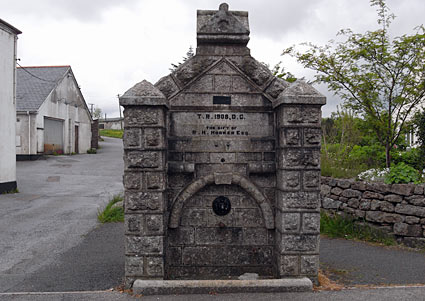Photos around Princetown, Devon,
A look around the Dartmoor town.
(Photos/words © urban75, May 2007)
The highest town on the moor at 1,400 feet above sea level and easily one of the wettest places in England, Princetown is best known for the infamous Dartmoor Prison.
Princetown owes its existence to Thomas Tyrwhitt who dreamt up grand designs to convert large areas of open moor inro arable farmland in the 18th century.
Founding the small community now known as Princetown, Tyrwhitt's agricultural dream flopped, so he came up with other wheezes to bring life into this bleak area, including the building of the prison.
Built to house prisoners from the Napoleonic Wars, the prison is still in use today and houses some 600 inmates.

One of two gatehouses flanking the B2312 at the entrance to Princetown.

The centre of Princetown.

Plume of Feathers Inn - read our review.

Railway Inn.

The impressive visitor centre.


Attractive floor mosaic inside the visitor centre.

The base of the large central lamp celebrating Queen Victoria's Jubilee in 1887.

Lord's Restaurant and Tea Rooms. The entire building has been closed on health and safety grounds.

A little further up is another abandoned building, with the old tea room waiting demolition for a crafts centre (whose construction seemed a little in doubt according to locals)..

Close up of the derelict house's front door, showing its 1905 building date.


Stone fountain, the gift of R H Hooker Esq in 1908.

Construction of the 1814 St Michael & All Angels Parish Church was started by French Prisoners-of-War who dug the foundations and erected the stone walls.
The job was finished by the American prisoners, who constructed the roof and fitted all the internal woodwork and fixtures, with prisoners paid 6d (2.5p) a day for their labours.
The east window of the church is a memorial to the 1200 French and 200 Americans who died whilst incarcerated at Dartmoor prison.

The entrance to St Michael & All Angels Church.

Standing 10 feet 4 inches (3.15 metres) high, this large cross in the church graveyard was erected in 1912 and acts as a memorial for prison inmates lying in unmarked graves.
Inmates who died in Dartmoor prison were buried in unmarked graves inside the prison before 1912, but after that date they were afforded the luxury of a plot on the north side of the churchyard.
Prisoner's graves are marked by a plain granite post, engraved with their initials and date of death.

Entrance to Dartmoor Prison.


A view of the visitor centre and Plume of Feathers Inn.

House with Union Jack.

Railway Inn and our shadows.

View of Princetown looking towards the site of the old railway station.
« Devon photos home Plume of Feathers review »
|
|

